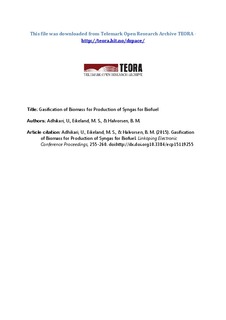Gasification of Biomass for Production of Syngas for Biofuel
Journal article, Peer reviewed
Published version
Permanent lenke
http://hdl.handle.net/11250/2438596Utgivelsesdato
2015Metadata
Vis full innførselSamlinger
Originalversjon
Adhikari, U., Eikeland, M. S., & Halvorsen, B. M. (2015). Gasification of Biomass for Production of Syngas for Biofuel. Paper presented at the 56th Conference on Simulation and Modelling (SIMS 56), October, 7-9, 2015, Linköping University, Sweden. http://doi.org/10.3384/ecp15119255Sammendrag
Continuously increasing price of oil and gas, energy crisis and increased environmental consciousness towards the greenhouse gas emission have opened a new opportunity to the biomass, the oldest source of energy known to mankind. The energy source neutral to CO2 needs to be utilized efficiently. One of the options to do so is gasification of biomass for transport biofuel production. In this work, the emphasis is on the composition of syngas production which can be further processed for conversion of biomass to transport biofuels. Biomasses such as wood chips are heated in a gasification reactor to produce a mixture of gases, mainly CO and H2. Process flow sheets for steam gasification of woody biomass have been simulated in the process simulation program ASPEN PLUS to study the process and to optimize the process parameters, materials, catalysts and reaction condition for syngas production.The Peng-Robinson equation of state with Boston-Mathias is selected for the considered model. The model describes the hydrodynamic parameter and reaction kinetics modeling. The required kinetic expressions and hydrodynamic equations are extracted from the literature. Gasification temperature, biomass moisture, steam to biomass ratio (STBR), air-fuel ratio, air and steam temperature are the most important operating parameters that is considered and studied to examine the gasifier performance. The impact of these process parameters on gasification is determined by sensitivity woody analysis. The results regarding composition of the syngas and the heating value for the considered biomass is compared with experimental data from the literature. The suggested model can be used as the guideline for more complex gasifier design and selection of the process equipment.
